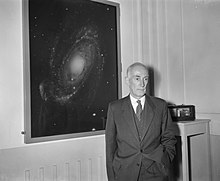
Back Jan Oort Afrikaans يان أورت Arabic يان اورت ARZ یان اورت AZB Ян Хендрык Оарт Byelorussian Jan Oort BS Jan Hendrik Oort Catalan Jan Oort Czech Jan Hendrik Oort Danish Jan Hendrik Oort German
Jan Oort | |
|---|---|
 | |
| Born | 28 April 1900 |
| Died | 5 November 1992 (aged 92) |
| Nationality | Dutch |
| Known for | |
| Awards | Vetlesen Prize (1966) Kyoto Prize (1987) |
| Scientific career | |
| Fields | Astronomy |
| Doctoral advisor | Jacobus Cornelius Kapteyn |
Jan Hendrik Oort FRS [1] (28 April 1900 – 5 November 1992) was a Dutch astronomer.
Oort made significant contributions to understanding the Milky Way,[2] and was a pioneer in the field of radio astronomy.[3] His New York Times obituary called him “one of the century's foremost explorers of the universe”.[4] The European Space Agency website describes him as, “one of the greatest astronomers of the 20th century”, and says he “revolutionised astronomy through his ground-breaking discoveries”.[5]
In 1955, Oort’s name appeared in Life Magazine’s list of the 100 most famous living people. He has been described as “putting the Netherlands in the forefront of postwar astronomy”.[4]
Oort proved that the Milky Way rotates. Finding that the visible mass was not enough to explain the rotation, he suggested the existence of invisible dark matter, in 1932. This is now thought to make up aboout 84.5% of the total matter in the Universe. Its gravitational pull causes “the clustering of stars into galaxies and galaxies into connecting strings of galaxies”.[4]
The Solar System's Oort cloud is named after him.
- ↑ Van De Hulst H.C. 1994. (1994). "Jan Hendrik Oort. 28 April 1900-5 November 1992". Biographical Memoirs of Fellows of the Royal Society. 40: 320–326. doi:10.1098/rsbm.1994.0042. S2CID 72529108.
{{cite journal}}: CS1 maint: numeric names: authors list (link) - ↑ Oort J.H. 1970. Galaxies and the universe: properties of the universe are revealed by the rotation of galaxies and their distribution in space. Science 170 (3965): 1363–1370. [1] Archived 2017-08-17 at the Wayback Machine
- ↑ Woltjer, Lodewijk 1993. (1993). "Obituary: Jan H. Oort". Physics Today. 46 (11): 104–105. Bibcode:1993PhT....46k.104W. doi:10.1063/1.2809110. Archived from the original on 2013-10-05. Retrieved 2016-05-04.
{{cite journal}}: CS1 maint: numeric names: authors list (link) - ↑ 4.0 4.1 4.2 Wilford, John (12 November 1992). "Jan H. Oort, Dutch astronomer in forefront of field, dies at 92". New York Times. Retrieved 30 May 2014.
- ↑ "Jan Hendrik Oort: Comet Pioneer". European Space Agency. Retrieved 30 May 2014.